Meth Head Slang
A “meth head” is a slang term for someone who uses or is addicted to methamphetamine – a powerful and highly addictive stimulant. This can include regular users, recreational users, or those struggling with long-term addiction.
Meth heads, or people addicted to methamphetamine, have developed their own terms and slang to describe their activities, lifestyle, and experiences related to their addiction. Common meth heads terms include ‘meth head’, ‘tweaker’, ‘crankster’, ‘speed freak’, and ‘meth junkie’. Other meth heads slang terms include ‘cooking up’, ‘chalk’, and ‘bumping’.
What Are Meth Heads?
Meth heads are people who abuse methamphetamines, a highly addictive stimulant drug. The effects of meth can be both short-term and long-term, ranging from feelings of euphoria to extreme agitation and violent behavior. People who use meth often become addicted quickly and suffer serious health consequences, including heart and brain damage, memory loss, psychosis, organ failure, and even death. In addition to being incredibly dangerous for the user’s physical health, meth heads can experience dangerous mental health implications, including depression and suicidal thoughts or behaviors. Unfortunately, the meth heads addiction problem is of epidemic proportion with no easy solution. With appropriate treatment programs and support from family members or friends, however, meth heads or meth addicts can find their way to recovery and lead healthy, productive lives.
Meth Heads Painful Developments
Meth heads can also suffer severe consequences due to the typical meth heads’ social life. Meth abusers often lose contact with family and friends. Many meth heads may feel isolated and alone due to their addiction and attempt to cope through behaviors like shoplifting or selling drugs to support their habit. Meth heads must seek professional help as soon as possible to find the treatment they need to get back on track. With therapy, medication, lifestyle changes, and support from loved ones, meth addicts can learn how to manage their addiction and move forward with their lives.
If you or someone you know is struggling with meth abuse, reaching out for help as soon as possible is essential. Contact a healthcare professional or an addiction recovery center for more information about meth addiction treatment options. By taking steps towards recovery, meth addicts can start on the path to a healthier, happier life.
It’s always possible to seek help and get back on track!
Meth Head Definition
Methhead is a methamphetamine addict (also called a “tweaker.”) Methheads are known for their extreme paranoia, flagrant dishonesty, and lack of non-methhead friends. The stereotypical definition of meth is that a meth head will steal your stuff and help you look for it.
Others say that “Meth Head” is used by law enforcement and those out there who have no clue what using meth is like and therefore have no first-hand knowledge of what meth does to the human mind and body. They use the term only to label meth users. It’s the same as calling a group of young men with baggy pants on thugs, or a group of young men with their heads shaved skinheads.
Just because someone has sores on their face doesn’t mean they use meth. That person probably never used a day in their life. Cancer, eczema, a bacterial infection, or allergic reaction can cause skin irritation.
Some people automatically think they must be on meth because they have messed up teeth. Bad teeth stem from genetics and or bad personal hygiene, and just because you see someone with bad teeth doesn’t mean they are on meth.
Your “typical” meth head likes to get high and often smokes throughout the day. They never stay in one place too long because they are always on the go. They house surf and carry a backpack with all their belongings. They will sell whatever they have to get a pipe load and may appear dirty because they typically neglect their hygiene while addicted to meth.
Meth Head Teeth
Deteriorating meth head teeth, termed Meth mouth, describes the damage that long-term meth use and abuse can do to one’s teeth. Symptoms of meth mouth include rapid tooth decay, tooth loss, dry mouth, stained teeth, and gums receding. It is important to note that this is reversible with proper dental hygiene, treatments, and lifestyle changes.
Pictured Below Are Meth Head Teeth
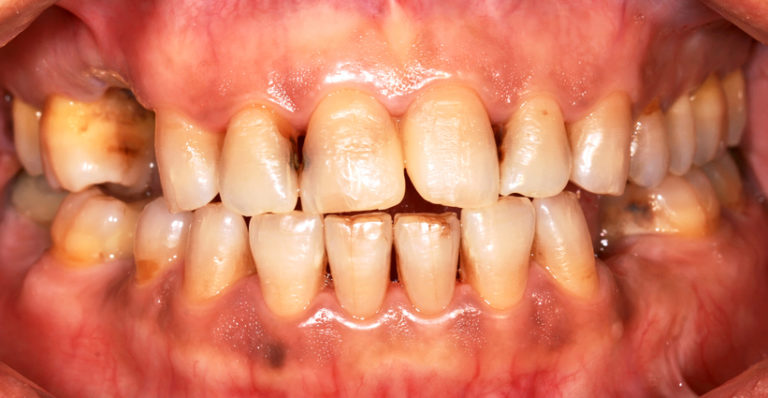
What Is A Functioning Addict?
Functioning addicts are the ones you don’t and won’t even suspect are meth users. They are not the stereotypical meth-heads. They are your rugged, clean-cut men and your prim and proper women that actively use meth every day and hold down good jobs. There is no look for a functioning meth head. Putting on a “methhead” label to functioning professional meth users can be inaccurate as they look just like any other professional.
Meth Heads Before and After

Signs of a Meth Head
Signs of meth use or addiction can vary from person to person. Still, the main warning signs typically include mood swings, increased energy, reduced appetite, excessive talking, agitation, paranoia, and violent outbursts. In some cases, long-term meth use can cause severe cognitive impairment, mental health problems, and significant physical health problems.
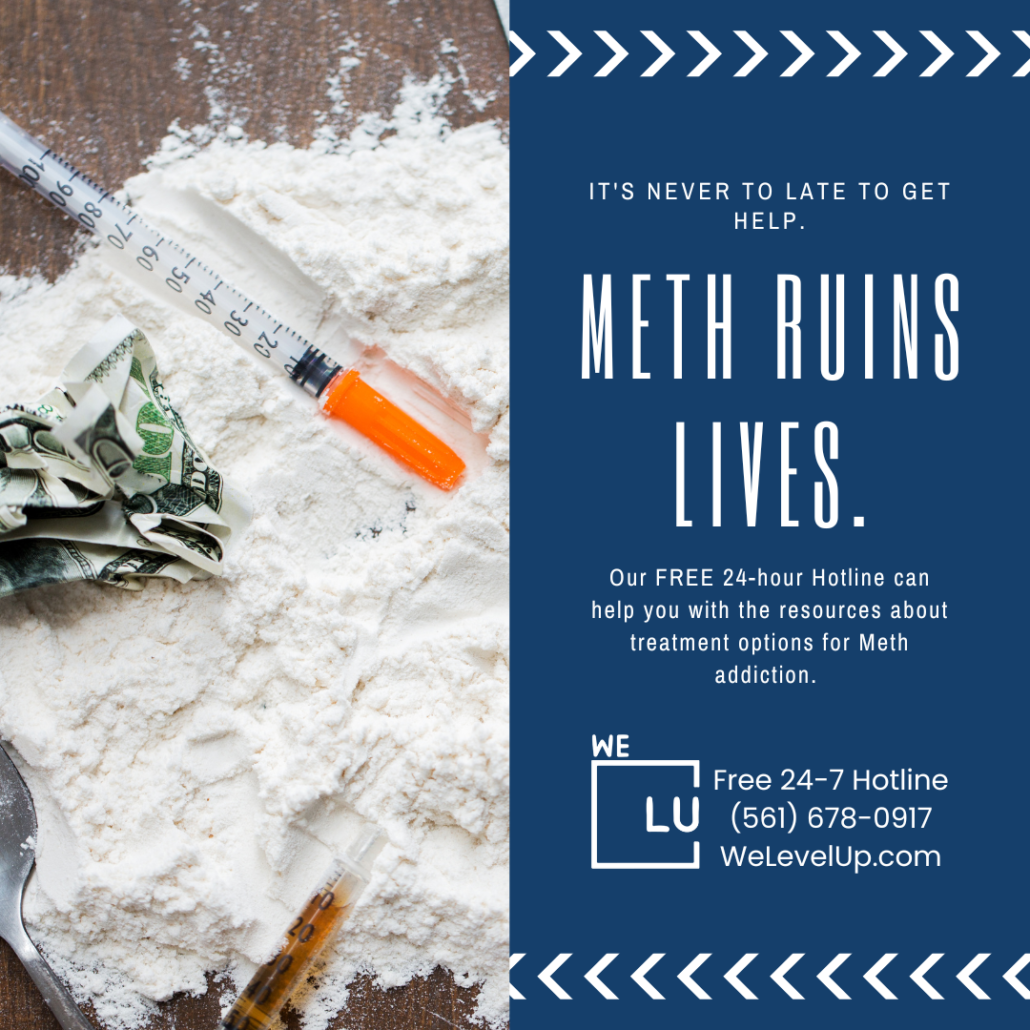
Meth Head Effects
Skip To:
- 6 Signs Of A Meth Head
- What Is A Meth Head?
- Methamphetamine Fact Sheet
- Meth Addiction Statistics
- What Is Meth?
- The Dangers Of Meth
- Meth Rewires The Brain
- Brain Damage From Meth Abuse
- Meth Head Teeth
- Recognizing A Meth Addiction
- 6 Most Popular Meth Head FAQs
- Find Treatment For Meth Addiction
Learn More:
- The Dangers Of Crystal Meth
- Faces Of Meth Before & After Photos, Signs, Meth Mouth, Meth Mites, Effects, Symptoms & Treatment
- How Long Does Meth Stay In Urine? Meth Drug Test Factors, Detox & Treatment
- What Does Meth Smell Like
- How To Identify Fake Meth, Risks & Effects of Addiction
- Meth Pupils – Effects of Meth on Eyes
- Illegal Stimulants Addiction
- Meth Effects
- Meth Mouth
- Meth Detox
- Meth Addiction Treatment
- Effective Addiction CBT Therapy
Meth Heads Symptoms Infographic
Meth heads are slang for someone who is addicted to methamphetamine and has become dependent on it for the effects it produces. People who use meth often develop an extreme reliance on it and may exhibit erratic behavior or compulsive mood swings. Meth addiction can lead to physical and mental health and financial and social problems.
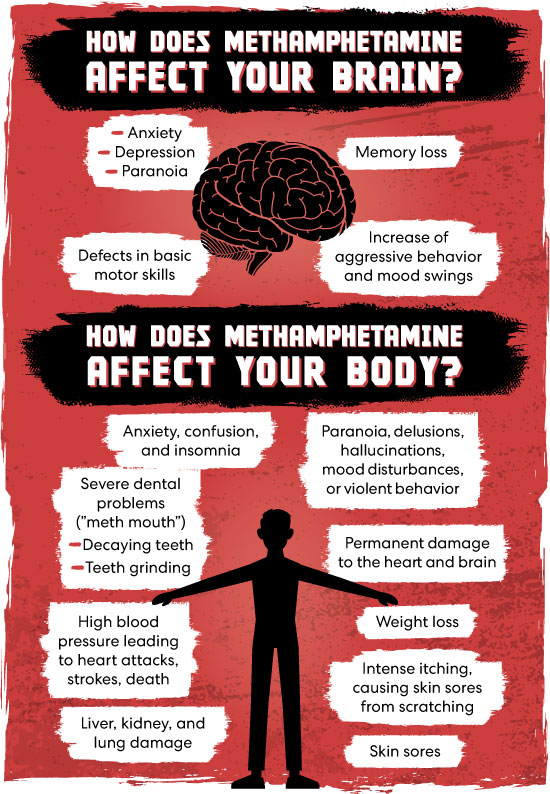
Source: LA County Department of Public Health – Substance Abuse Prevention and Control
6 Signs Of A Meth Head
Methamphetamine is a drug that does not allow much room for casual use. Users quickly become addicts. Users’ health quickly deteriorates, as does their ability to tend to basic personal hygiene. Meth is often referred to as the “dirty drug.” The physical signs of meth abuse include:
- Eye Movement: Rapid eye movement and dilated pupils.
- Low Body Weight: Users lose weight rapidly and often appear sick.
- Dental Problems: Meth use causes severe tooth decay.
- Skin Sores: Users usually pick at imaginary bugs under their skin (“meth bugs”), causing open sores, infections, and skin scarring.
- Body Odor: Chemicals are emitted from the skin of meth users, often producing strong and unpleasant odors.
- Pale Facial Appearance: Users’ faces often appear pale or splotchy and may be sweaty.
Methamphetamine users will also be paranoid, jittery, and anxiety-ridden. They may communicate with senseless and irrational babble, and their speech may be impaired. They are prone to moodiness and violent outbursts.
In conclusion, meth heads suffer from a dangerous addiction that can cause severe physical and mental health consequences. With the proper treatment and support, meth addicts can find ways to manage their addiction and reclaim their lives.
Methamphetamine Fact Sheet
Methamphetamine is intended to treat attention-deficit hyperactivity disorder (ADHD). Unfortunately, methamphetamine – meth for short – is a very addictive stimulant drug.
Methamphetamine Stimulant
When medically supervised, it can help treat ADHD. It can also aid in the weight loss of obese patients.
Methamphetamine Controlled Substance
It can lead to heart failure, delirium, panic attacks, rapid or irregular heartbeat, and psychosis.
Methamphetamine is a Schedule II stimulant under the Controlled Substances Act, which means that it has a high potential for abuse and a currently accepted medical use (in FDA-approved products). It is available only through a prescription that cannot be refilled. Today there is only one legal meth product, Desoxyn®.
Methamphetamine Availability
For legal use, it’s only available on prescription only.
Methamphetamine & Pregnancy
Consult a physician.
Methamphetamine & Alcohol
Avoid. There may be severe interactions.
Meth Addiction Statistics
According to the Centers for Disease Control and Prevention, from 2015 to 2018, an estimated 1.6 million U.S. adults aged 18 years and above, on average, reported past-year meth use; 52.9% had a meth addiction, and 22.3% reported injecting meth within the past year. In addition, co-occurring substance use and mental illness were everyday struggles among those who used meth within the past year.
2.6 million
In 2020, 0.9%, or around 2.6 million people, reported taking methamphetamine in the previous 12 months.
Source: National Institute On Drug Abuse
0.2%
In 2021, it is projected that 0.2% of eighth-graders, 0.2% of tenth-graders, and 0.2% of twelfth-graders used methamphetamine in the previous year.
Source: National Institute On Drug Abuse
1.5 million
Methamphetamine abuse in the previous 12 months affected a projected 0.6% (or 1.5 million) of individuals aged 12 or older in 2020.
Source: National Institute On Drug Abuse
What Is Meth?

Methamphetamine, commonly known as meth, crystal meth, and methamphetamine tablets, is the most widely used synthetic drug globally [1]. It’s a highly addictive illegal stimulant that dramatically affects the central nervous system (brain and spinal cord). Meth addiction has devastating effects, which cause lung disorders, kidney damage, hyperthermia, stroke, and cardiac arrest. Oral or dental disease, including meth mouth, was one of the most prevalent (41.3 percent) medical comorbidities in meth heads [2].
These psychoactive drugs give “meth heads” a rush of energy and intense feelings of pleasure. It is made from household products and agricultural chemicals with pseudoephedrine or ephedrine, a decongestant in over-the-counter cold remedies like Sudafed. Meth is popular and very addictive because of the euphoric effects it gives its users. However, it’s illicit because its continuous consumption has been proven to alter and destroy brain functions, resulting in a stroke, psychosis, or even death.
Meth has been classified by the U.S. Drug Enforcement Administration (DEA) [3] as a Schedule II controlled substance, making it legally available only through prescription. Medically it may be used to treat attention deficit hyperactivity disorder (ADHD) and as a short-term component of weight-loss treatments. However, these uses are limited, and it is rarely prescribed. Also, the prescribed doses are far lower than those typically misused. The FDA-approved brand-name medication is Desoxyn.

Get Your Life Back
Find Hope & Recovery. Get Safe Comfortable Detox, Addiction Rehab & Mental Health Dual Diagnosis High-Quality Care at the We Level Up Treatment Centers Network.
Hotline (877) 378-4154The Dangers Of Meth
- Even taking small amounts of meth can cause harmful health effects, including:
- Increased blood pressure and body temperature
- Faster breathing
- Rapid or irregular heartbeat
- Loss of appetite, disturbed sleep patterns, or nausea
- Erratic, aggressive, irritable, or violent behavior
- Chronic meth use can lead to many damaging, long-term health effects, even when people stop taking meth, including:
- Permanent damage to the heart and brain
- High blood pressure leads to heart attacks, strokes, and death.
- Liver, kidney, and lung damage
- Anxiety, confusion, and insomnia
- Paranoia, hallucinations, mood disturbances, delusions, or violent behavior (psychotic symptoms can sometimes last for months or years after meth use)
- Intense itching, causing skin sores from scratching
- Premature osteoporosis
- Severe dental problems
Meth Heads Before and After Pictures

Meth Heads Before and After Images
Meth heads before and after meth use can be vastly different. Before meth, a person may appear healthy and happy, with no signs of drug use or addiction. However, meth users soon start to show physical and psychological changes. These changes include weight loss, tooth decay, sores on the skin from picking at perceived bugs (formication), paranoia, and agitation.
Before and after meth heads photos illustrate the devastating effects of meth abuse.

Cognitive impairment also begins as meth affects the brain’s functioning ability. All these symptoms can lead to more significant problems, such as mood swings, aggression, and other mental health issues that persist even after meth has been stopped. Long-term meth users often struggle with severe depression and anxiety, which can be hard to manage without therapeutic help. Ultimately, meth is highly addictive and can have devastating consequences for users and their loved ones. Therefore, meth users should seek professional help to get clean and stay clean from meth use.
Get Help. Get Better. Get Your Life Back.
Searching for Accredited Drug & Alcohol Rehab Centers Near You? Or Mental Health Support?
Even if you have failed previously, relapsed, or are in a difficult crisis, we stand ready to support you. Our trusted behavioral health specialists will not give up on you. Call us when you feel ready or want someone to speak to about therapy alternatives to change your life. Even if we cannot assist you, we will lead you wherever you can get support. There is no obligation. Call our hotline today.
FREE Addiction Hotline – Call 24/7Meth Rewires The Brain
Heavy or long-term methamphetamine use damages the brain both functionally and structurally. In addition, a person’s brain becomes accustomed to the drug during addiction.
This altered biochemical activity may take time to normalize once the drug is stopped. In most cases, it will—as some dysfunction in the brain’s neurons can eventually right itself.
From a brain structure standpoint, reversal is not always so easy. Ultimately, meth causes damage to brain cells. The ability to reverse the damage largely depends on where the injury occurred.
If damage occurs in an area where other brain cells can compensate, a person’s symptoms will likely improve. If damage occurs where cells are more specialized and have fewer redundancies, the repair can be difficult, if not impossible.
There are three ways that long-term meth use can damage the brain:
- Causing acute neurotransmitter changes
- Causing brain cell death
- Rewiring the brain’s reward system
Heavy meth use is known to cause cell death in parts of the brain associated with self-control, including the frontal lobe, caudate nucleus, and hippocampus. Damage in these areas can manifest in a variety of psychiatric symptoms.
Comfortable Facilities & Amenities
High-Quality Addiction & Mental Health Rehabilitation Treatment
Rehab Centers TourRenowned Addiction Centers. Serene Private Facilities. Inpatient rehab programs vary.
Addiction Helpline (877) 378-4154Proven recovery success experience, backed by a Team w/ History of:
15+
Years of Unified Experience
100s
5-Star Reviews Across Our Centers
10K
Recovery Success Stories Across Our Network
- Low Patient to Therapist Ratio
- Onsite Medical Detox Center
- Comprehensive Dual-Diagnosis Treatment
- Complimentary Family & Alumni Programs
- Coaching, Recovery & Personal Development Events
Brain Damage From Meth Abuse
Long-term meth users may develop life-long problems with verbal skills and memory. They may even develop Parkinson’s disease, an incurable nervous disorder with trembling hands and extreme muscle stiffness symptoms. Animal studies show as much as 50 percent of the dopamine-producing cells in the brain can be damaged after long-term exposure to relatively low levels of methamphetamine [4]. In other animal studies, a single high dose of the drug has been shown to damage nerve endings in the dopamine-containing regions of the brain. The nerve endings do not die but do not grow back to their original sizes.
Meth Head Teeth
Why do meth heads have bad teeth? Meth mouth is a term used to describe the visible effects of oral disease in an individual who uses meth because of the widespread tooth decay that often happens with the drug’s use. People who use meth may have stained, blackened, broken, or rotting teeth, both due to side effects of the drug itself and related lifestyle factors.
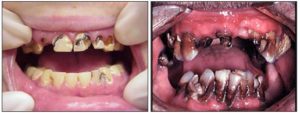
Recognizing Meth Addiction
If an individual is regularly using meth, when they try to stop, they will experience severe withdrawal symptoms. This may be a clue to an addiction when the individual cannot score drugs or is attempting to detox alone. Although the withdrawal is not as threatening as other drugs, it is still uncomfortable.
Symptoms of meth withdrawal will include exhaustion, cold sweats, anxiety, cravings, suicidal thoughts, and nausea. An individual attempting to detox from meth should experience withdrawal symptoms in a medical detox facility so that a medical professional overlooks them. This enhances the comfort of the patient and ensures their safety.
World-class, Accredited, 5-Star Reviewed, Effective Addiction & Mental Health Programs. Complete Behavioral Health Inpatient Rehab, Detox plus Co-occuring Disorders Therapy.
CALL (877) 378-4154End the Addiction Pain. End the Emotional Rollercoaster. Get Your Life Back. Start Drug, Alcohol & Dual Diagnosis Mental Health Treatment Now. Get Free No-obligation Guidance by Substance Abuse Specialists Who Understand Addiction & Mental Health Recovery & Know How to Help.
7 Most Popular Meth Head FAQs
-
Why Do Meth Heads Dig At Their Skin?
If you are wondering, “do meth heads like to dig?”, the answer is that meth heads digging at the skin is typically a symptom of methamphetamine psychosis since the person imagines something on their skin that isn’t there.
-
Does Meth Affect Women Differently?
According to recent studies, meth usage has a more substantial adverse effect on a meth head woman than a meth head man. According to a study by the RSNA, meth-using women had significantly less gray matter volume (GMV) in their brains.
-
What Does A Meth Head Face Look Like?
If you are wondering, “what does a meth head look like?”, the answer is that meth addicts may experience “meth mites,” or the sensation of bugs crawling under the skin, which may cause them to scratch themselves constantly, leading to meth head sores and meth head scabs.
-
What Is The Typical Meth Head Meaning?
The meaning of meth head is slang for an addict of methamphetamine (also known as “tweeker”.) Methamphetamine misuse leads to irreparable brain and central nervous system damage. Resulting in a lack of impulse control, extreme paranoia, extreme lack of empathy, and extreme lack of cognitive ability. However, meth addiction is typically a hopeless condition without proper treatment.
-
How Do Meth Heads Act?
Meth users frequently have particular bodily meth head symptoms. If you’re wondering how to spot meth users, meth head behavior may include increased vigor or physical activity and decreased hunger.
-
Why Do Meth Heads Lose Teeth?
If you are wondering, “why do meth heads lose their teeth?”, the answer is that meth addiction has major oral side effects, including poor tooth health, referred to as “meth mouth.” A meth user’s oral health will rapidly deteriorate, starting with discoloration, followed by teeth that are rotting and decaying, severe gum disease, and eventually, losing all of their teeth.
-
Why do meth heads dig?
One of the side effects of meth use is intense cravings for the drug leading to a range of behaviors like digging and other repetitive actions.
Digging behavior can be caused by many factors, but one common theory is that it is related to the stimulant effects of meth. Methamphetamine can cause users to experience increased focus, energy, and drive, which may lead to repetitive or compulsive behaviors like digging.
In addition, some people who use meth might engage in digging or other repetitive actions as a form of self-soothing or coping mechanism for anxiety and stress related to meth use or other personal issues.
Find Treatment For Meth Heads. Find Meth Addiction Treatment that Works.
First and foremost, if you think a loved one is using meth, you should research the drug and addiction to understand better what you loved one needs. Next, you must plan an intervention to provide your loved one with options to battle their addiction in a supportive environment. During this intervention, offer support and compassion instead of judgment. Lastly, show your support throughout the entire treatment process.
Clearing meth from the body and overcoming withdrawal symptoms is the goal of detox, which is the first step of treatment for meth addiction. Here at We Level Up NJ, a comprehensive team prescribing medications can alleviate your withdrawal pains while monitoring your health 24 hours during the detox. We prioritize your safety and comfort because this is a fragile and challenging time for you.
Once detox is complete, a new treatment doorway opens up, referred to as a residential level of care. Our residential care program slowly and effectively introduces the individual into an atmosphere of therapeutic growth, marked by master’s level therapists, clinicians, group counselors, psychiatrists, and a community of like-minded individuals with the same aim: to attain sobriety and live a great life.
Some of the many modalities applied and practiced within our residential treatment facility are:
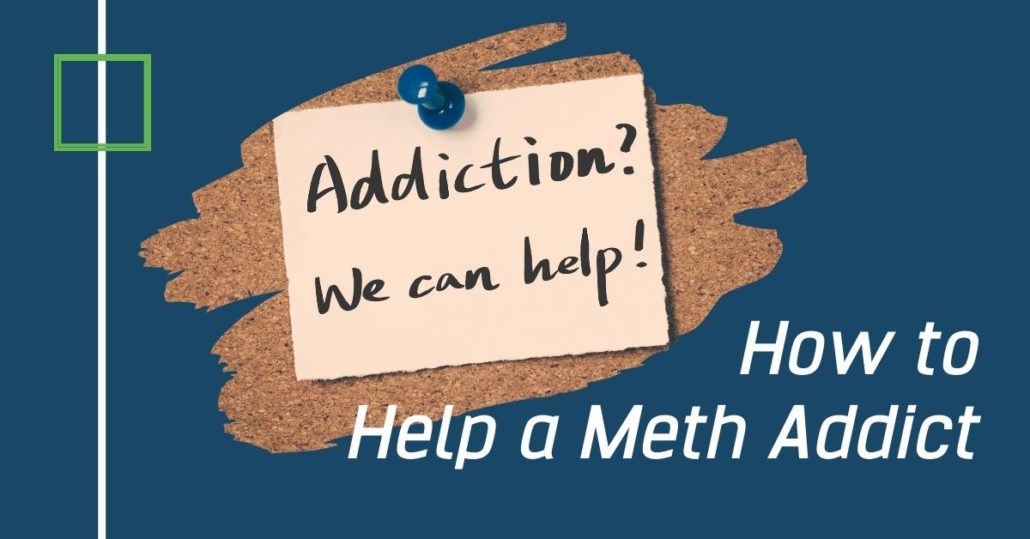
Our treatment tailors the program to the individual and the individual to the program of recovery. We begin by assessing our client’s history of mental health, drugs, and alcohol-related past. The needs of each patient are specific and personalized because we aim to provide comprehensive support for mental health, addiction, and dual diagnosis treatment. Our supportive environment is designed accordingly to give patients 24-hour care for sobriety. Most importantly, we hope to have our patients live comfortably within the facility during this crucial and fragile time.
To say “meth head” is similar to stereotyping a group of people based on a characteristic. It, along with many other terms like “crack head” or “nerd,” is derogatory and can make one not come across in a manner to be taken seriously. One shouldn’t stereotype substance users just as one shouldn’t stereotype race, gender, age, etc.
We prioritize removing the stigma and temptations for relapse and applying an air of recovery into every component of the treatment timeline. At We Level Up NJ, clients live and recover in a supportive community. Especially during their early recovery process, they can genuinely focus on what matters most, their recovery.
Experience Transformative Recovery at the We Level Up Treatment Center.
See our authentic success stories. Get inspired. Get the help you deserve.



Start a New Life
Begin with a free call to an addiction & behavioral health treatment advisor. Learn more about our dual-diagnosis programs. The We Level Up treatment center network delivers various recovery programs at each treatment facility. Call to learn more.
- Personalized Care
- Caring Accountable Staff
- Comfortable Amenities
- Licensed & Accredited
- Renowned w/ 5-Star Reviews
We’ll Call You
Search We Level Up NJ Meth Addiction Resources
Sources
[1] Karila L, Weinstein A, Aubin HJ, Benyamina A, Reynaud M, Batki SL. Pharmacological approaches to methamphetamine dependence: a focused review. Br J Clin Pharmacol. 2010 Jun;69(6):578-92. DOI: 10.1111/j.1365-2125.2010.03639.x. PMID: 20565449; PMCID: PMC2883750.
[2] Galbraith N. The methamphetamine problem: Commentary on … Psychiatric morbidity and socio-occupational dysfunction in residents of a drug rehabilitation center. BJPsych Bull. 2015 Oct;39(5):218-20. doi: 10.1192/PB.bp.115.050930. PMID: 26755964; PMCID: PMC4706185.
[3] Patterns and Characteristics of Methamphetamine Use Among Adults — United States, 2015–2018 – Centers for Disease Control and Prevention
[4] Methamphetamine – U.S. Department of Health and Human Services National Institutes of Health
[5] Yasaei R, Saadabadi A. Methamphetamine. [Updated 2022 May 8]. In: StatPearls [Internet]. Treasure Island (FL): StatPearls Publishing; 2022 Jan-. Available from: https://www.ncbi.nlm.nih.gov/books/NBK535356/
[6] Richards JR, Laurin EG. Methamphetamine Toxicity. [Updated 2022 Oct 10]. In: StatPearls [Internet]. Treasure Island (FL): StatPearls Publishing; 2022 Jan-. Available from: https://www.ncbi.nlm.nih.gov/books/NBK430895/
[7] Methamphetamine DrugFacts – National Institute on Drug Abuse
[8] Methamphetamine – DEA.gov
[9] Drug Fact Sheet: Methamphetamine – DEA.gov
[10] Know the Risks of Meth – SAMHSA